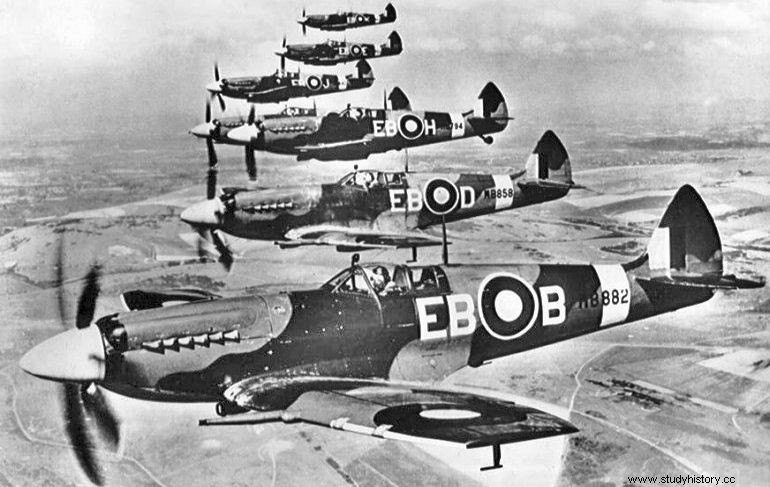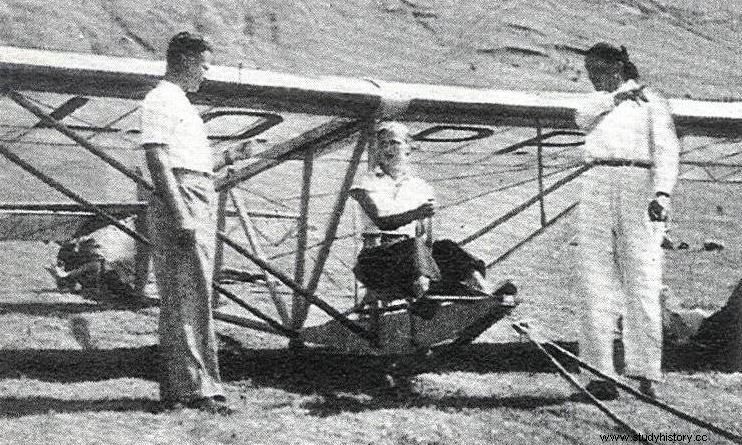Nobody is surprised by the sight of the ladies at the controls of combat planes. Still 75 years ago it was unimaginable. It was not until the outbreak of World War II that women began to fly fighters. Among these pioneers there were also three extraordinary Polish women.
In Great Britain, the paramilitary organization Air Transport Auxiliary (ATA) handled the distribution of planes from factories to military airports. In addition to the citizens of the kingdom, foreigners also served there. The first Pole in ATA was the legendary LOT pilot, 2nd Lt. Klemens Długaszewski, well known among his aviation brothers as Double Whiskey .
With the increase in aircraft production and the intensification of air operations, the demand for ATA services grew rapidly. As many pilots as possible were needed, strict criteria were not applied to them. View of an elderly, lame and one-eyed knight of the sky getting out of a hunting Hurricane shocked no one. The pilots themselves ironically deciphered the abbreviation of their formation as Ancient and Tattered Airmen - Starzy i Potargani Lotnicy .

Machines such as the Supermarine Spitfire Mk XII belonging to RAF 41 Squadron flew lame old men ... and beautiful and young women (source:public domain).
Airplanes cleaners?
Since the RAF has placed elderly invalids in its precious machines, nothing should prevent young and healthy girls from sitting in them as well. However, it was not in the minds of the commanding officer of the Royal Air Force.
They proclaimed that women were unworthy of this privilege both physically and personally. Many Brits thought the same. Readers of the venerable aviation magazine "Airplane" could find out, for example, that the ladies who wanted to pilot the bombers did not have the intelligence to scrub the floor properly .

Spitfire not for everyone
Nevertheless, in January 1940, the first eight women entered the ATA women's section. Over time, others joined. The first foreigners to join their ranks at the beginning of 1941 were Polish women:Anna Leska and Stefania Wojtulanis. In July 1942, Jadwiga Piłsudska, daughter of the first Marshal of Poland, joined them.
ATA pilots were never formally part of the RAF, although they received British military ranks for the duration of the war. They were only stationed at civilian air bases such as White Waltham and Hamble. Also women from ATA earned the nickname: Always Terrified Airwomen - Always Terrified Aviators .

Four handsome and not scared pilots! The daughter of the Marshal, Jadwiga Piłsudska (source:public domain), goes third from the left.
Pilots could initially only fly on school machines. They fought for two years to be able to sit at the controls of fighters, including spitfires. Ultimately, eleven women were even authorized to fly the heaviest four-engine bombers. Wherever they appeared, the girls on airplanes always caused a sensation. There is a story about Anna Leska, how she landed at a certain British air base:
Every now and then everyone looks anxiously at the sky, wondering if the long-awaited Spitfire has not been shot down somewhere by the German Luftwaffe. Finally, a dark fighter shape appears above the horizon. A collective breath of relief hovers over the airport.
A moment later the plane lands. On the steps there is a figure of a woman in a brown flight suit. After a moment's hesitation, one of the waiting soldiers hesitantly asks: "When will the captain appear?" "Right in front of you ...".

Anna Leska was a master of a sharp retort (illustration by Joanna Wójcik from the book "Historia Polski 2.0:a Pole can, a Pole too ...").
Who needs a radio?
The service was very demanding, even for such experienced pilots as Leska or Wojtulanis. As Jan and Ewa Wróbel wrote in the book "Historia Polski 2.0:a Pole can, a Pole too ... ":
These were ungrateful tasks, firstly because they were not as glorious as the combat flights over Germany. Secondly, there were many restrictions imposed on pilots (and female pilots). For example, it was forbidden to fly in the clouds (...). This is because the air defense gun crew was firing instinctively at the planes hiding in the clouds, because aviation could turn out to be German. The radio was not allowed. There was a total ban on making figures, even an innocent "barrel" .
The weather was usually not included in the aircraft distribution plans. The priority was to quickly deliver the machine from point A to point B. For economic reasons, no one taught the aviators how to fly by instruments in conditions of limited visibility. In addition, their planes were deprived of ammunition. When encountered, Luftwaffe fighters did not differ much from shooting targets.

One of the few navigation training flights over the ATA base in White Waltham, performed on Airspeed As.10 Oxford (source:public domain).
Notes on the importance of life
The scrap machines were the worst. Some wise head in the RAF concluded that they could only be delivered to the cassation site by air. Piloting a rickety and riddled bomber over Germany, certified as "only one landing!" must have taken a lot of stress.
It was also necessary to switch from one type of plane to another non-stop, often without any preliminary training. A special crosscutter known as "Notes of the distributor pilot" was extremely helpful in such situations. It contained a set of basic technical parameters of over a hundred types of machines. The pilot usually had about half an hour to familiarize himself with it just before take-off.
Salto mortale of Jadwiga Piłsudska
The more bloody pilots disregarded the ban on aviation evolutions. According to one of the reports, Jadwiga Piłsudska shot a beautiful beam of acrobatics with a spitfire just above the head of the RAF base commander. The one, irritated by the pilot's behavior, was going to put him in a jail for breaking safety regulations.
You could imagine his expression when it turned out that the mad flier was a woman. The epilogue was that the British had a lunch for Piłsudska in the officer's wardroom, and a round of whiskey for everyone there!
Our aviators sometimes encountered real originals or even eccentric freaks. For example, the supply officer at White Waltham base intended the most seriously in the world to get elephants from the circus to pull airplanes.

17-year-old Jadwiga Piłsudska in 1937 was just learning how to drive aircraft, and a few years later her acrobatics amazed the command (source:public domain).
In turn, Cpt. Douglas Fairweather was famous for the fact that he sometimes carried a goat on a plane. He also used a map of Great Britain from Roman times to navigate and measured the distance traveled with the number of cigarettes smoked while flying in the clouds!
Fun in the lesbian base
All the pilots were young, temperamental women who liked to have a good time. They also did not shy away from male company. There were often various rumors about them, sometimes even legends. The sensationalist guys at the RAF even called Hamble the "lesbian base".
Lasting friendships were also formed, but were rarely international in character. As Piłsudska recalled: In England, you should be well off in order to fly. My friends (ie British women) were very wealthy, ladies from serious households, they liked games and flirting. We lived a bit differently.

Some ladies could not find a common language with each other. The dispute between Anna Leska and the Chilean Margot Duhalde was particularly fierce. Both women fought for everything, both on the ground and in the air. The situation was only mastered by the intervention of the command and the threat that one of them would be dismissed from service.
Notable stats
A total of 166 volunteers served in ATA. Apart from British and Polish women, there were women from the USA, Canada, Australia, New Zealand, South Africa, Argentina and even Chile. Their class as pilots is evidenced by statistics, and it is worth remembering that no reduced fare was applied to them.
During World War II, ATA airmen delivered over 308,000. aircraft. 170 pilots of this formation, including 15 women, were killed. One in ten flyers died. About 30% of men died and this figure was comparable to the losses of British fighter aviation.

A poster praising Polish aviators by Joanna Wójcik (the illustration comes from the book by Jan and Ewa Wróbel "History of Poland 2.0:a Pole can, a Pole too ...").
Stefania Wojtulanis was the first Polish woman to fly 1000 hours on combat aircraft. Anna Leska, on the other hand, was honored with the Golden Wings badge, awarded for a flight time of more than 6000 hours.
Jadwiga Piłsudska during the year and a half of service she flew about 230 aircraft of 21 different types. She spent over 312 hours in the air. At that time, she did not have any accident, she did not damage any plane. As assessed by British superiors, she was an extremely promising pilot with above-average skills .
